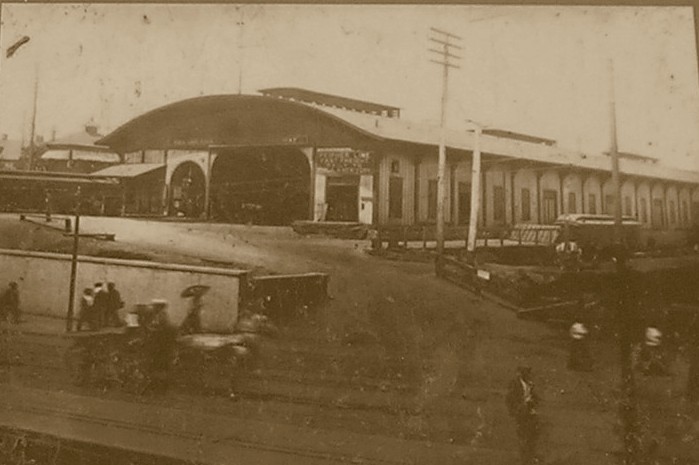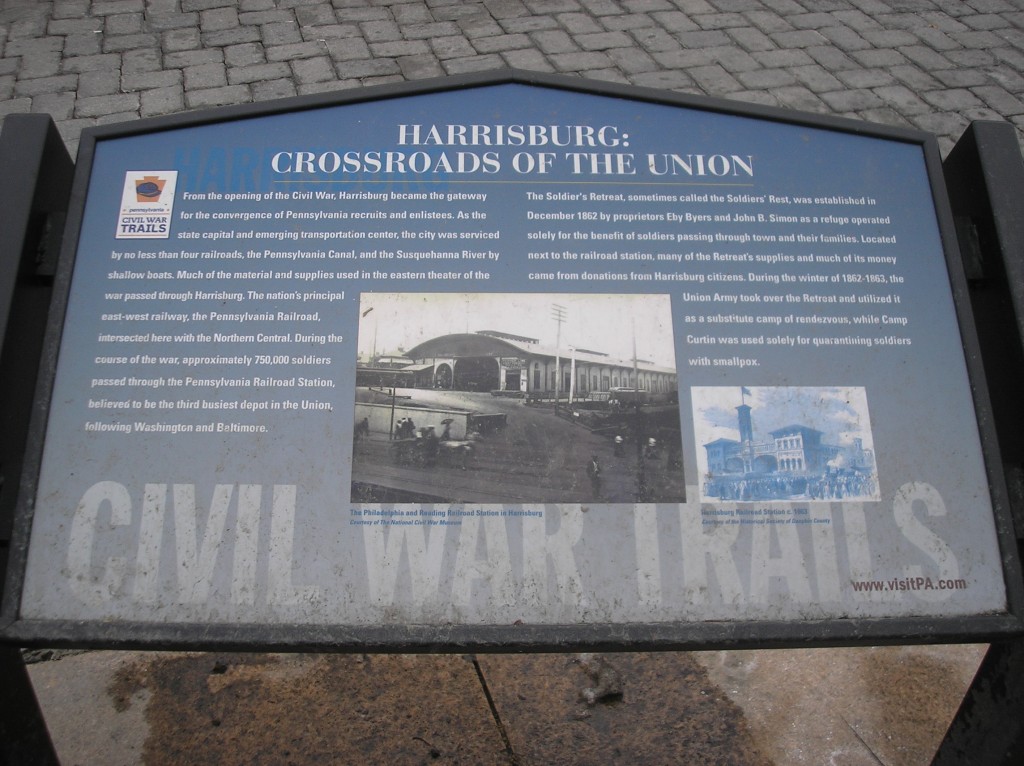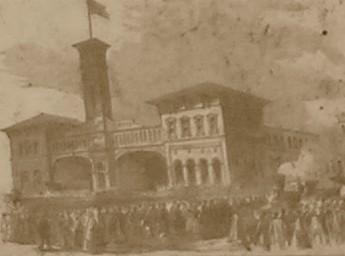Harrisburg – Crossroads of the Union
Posted By Norman Gasbarro on March 24, 2011
Just outside the current Harrisburg Transportation Center, there are two historical markers recognizing the history of rail transportation in Harrisburg and the historical nature of the site. In today’s post, one of the markers will be examined. In tomorrow’s post, the other marker will be discussed along with some additional thoughts about the role of the railroads in the post-Civil War period.
The Civil War Trails marker contains the following wording:
From the opening of the Civil War, Harrisburg became the gateway for the convergence of Pennsylvania recruits and enlistees. As the state capital and emerging transportation center, the city was serviced by no less than four railroads, the Pennsylvania Canal, and the Susquehanna River by shallow boats. Much of the material and supplies used in the eastern theater of the war passed through Harrisburg. The nation’s principal east-west railway, the Pennsylvania Railroad, intersected here with the Northern Central. During the course of the war, approximately 750,000 soldiers passed through the Pennsylvania Railroad Station, believed to be the third busiest depot in the Union, following Washington and Baltimore.
The Soldier’s Retreat, sometimes called the Soldiers’s Rest, was established in December 1862 by proprietors Eby Byers and John B. Simon as a refuge operated solely for the benefit of soldiers passing through town and their families. Located next to the railroad station, many of the Retreat’s supplies and much of its money came from donations from Harrisburg cvitizens. During the winter of 1862-1863, the Union Army took over the Retreat and utilized it as a substitute camp of rendevous, while Camp Curtin was used solely for quarantining soldiers with smallpox.
The Harrisburg Railroad Station of the Pennsylvania Railroad was used by the Northern Central Railroad, which went from Sunbury, Pennsylvania, through the Lykens Valley area, to Baltimore, Maryland. The station, as it appeared in 1863 is pictured on the historical marker. The picture appears to be an engraving rather than a photograph.
Nearly all of the soldiers from the Lykens Valley area who traveled to Harrisburg on their way to the war would have seen this station – and would have passed through or stopped at the station on their way home.
One of the problems faced by Civil War era researchers is that there are very few railroad station photographs from that time period. The ones we have of the Harrisburg Railroad Station were taken because of Lincoln’s funeral train. As previously mentioned in another post, the Summit Branch Railroad which went from Lykens, Pennsylvania to Millersburg, Pennsylvania, had station buildings at every stop, but not one photograph has yet been found from the Civil War period.
The other station pictured on the marker is that belonging to the Philadelphia and Reading Railroad. It is hoped that in later posts, first-hand impressions of soldiers who traveled from or through the Lykens Valley area to Harrisburg will be presented.

Philadelphia and Reading Railroad Station, Harrisburg, Pennsylvania. Adapted from the photograph on the plaque. Original from National Civil War Museum.
One of the difficulties of train travel in mid-19th century was that different railroad companies had their stations in different parts of towns and cities. Arriving in Harrisburg by one railroad company, travelers had to find a way to get to another station to continue their journey. Very few railroads “connected” with other railroads directly and very few railroads allowed the cars and engines from another railroad to travel on the rails of their railroad. The Civil War pointed out the necessity to join lines together, and some towns and cities began to move toward the “union” stations concept. These “union” stations were either built cooperatively by otherwise competing railroads or they were supported and built by cities wishing to make it convenient for travelers. Harrisburg had no “union” stations in the period 1861-1865, but the Pennsylvania Station in Harrisburg was considered the “main” station because the primary east-west line was the Pennsylvania Railroad, and the primary north-south railroad was the Northern Central Railroad, which was operated by the Pennsylvania Railroad.
In tomorrow’s post the other historical marker at the Harrisburg Transportation Center will be discussed. In future posts is is hoped that first-hand accounts of soldiers who traveled through these stations can be presented. Anyone with any information that can enhance our understanding of the importance of Harrisburg as the “Crossroads of the Union,” particularly if it pertains to persons who were from or who were traveling through the Lykens Valley area, can contribute to the comments for this post.
This “Civil War Trails” historical marker is sponsored by www.visitpa.org. The pictures of the stations are from the marker and are browntoned of an “old photo effect.”
 ;
;




Comments